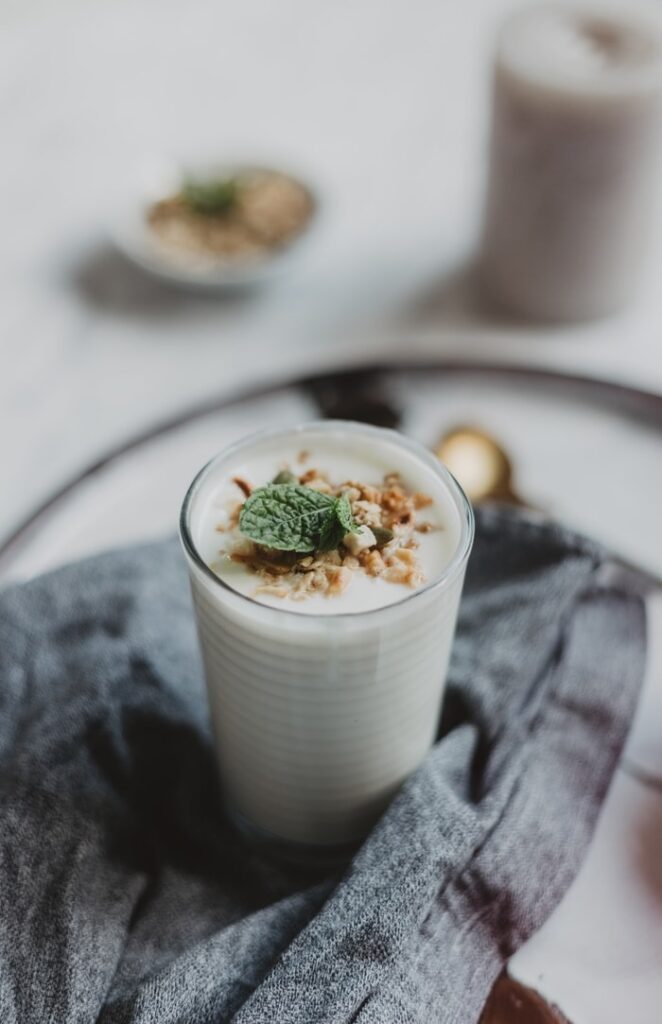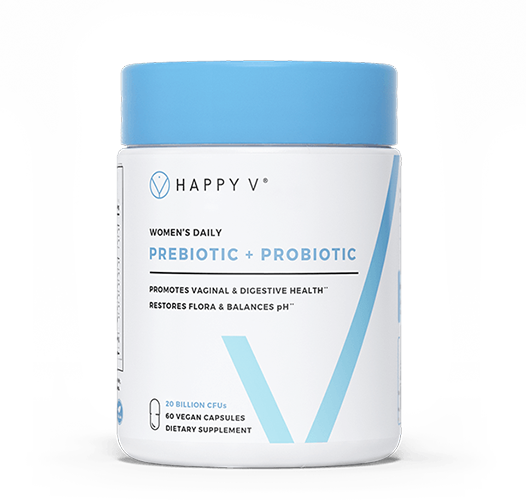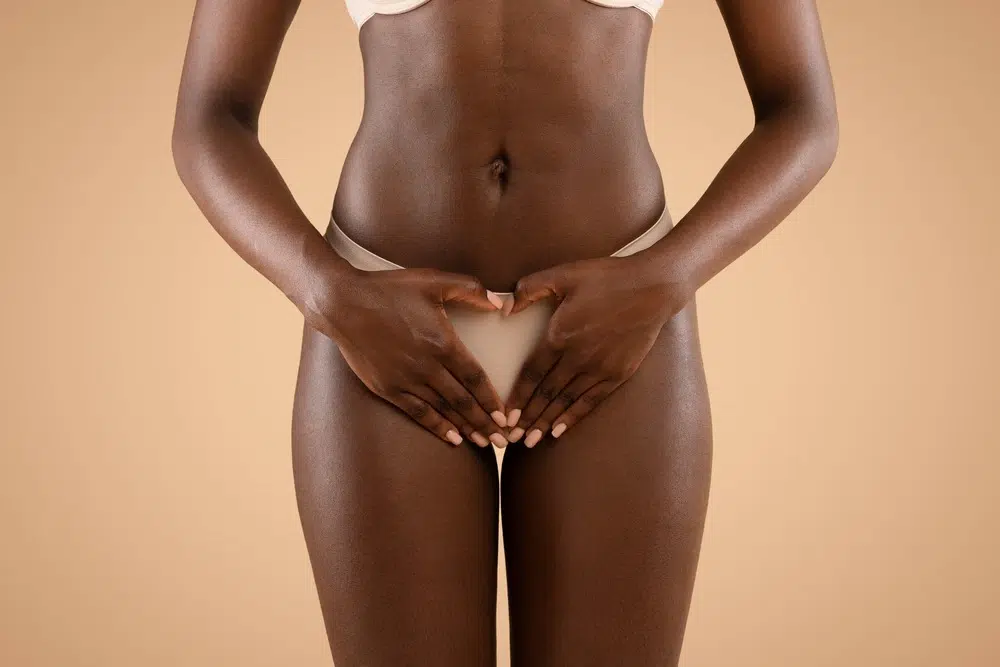- Maintaining proper levels of lactobacillus in your body can help you stay healthy and fight off certain infections. Good bacteria like lactobacillus are called probiotics, and they help regulate your body’s natural processes and fight off growth of bad bacteria that cause infections, like bacterial vaginosis.
- Lactobacilli species make up for a huge part of the vaginal microbiome and are essential for keeping the vaginal environment in good health.
- In order for it to be effective for bacterial vaginosis, your lactobacillus probiotics should contain at least 1 billion CFUs per dose.
Lactobacillus is a genus of bacteria naturally found in the body—particularly in organs of the digestive and genital system—and in many different foods including dairy products and fermented foods like kimchi. There are many different species of lactobacillus, but they all have one thing in common—they produce lactose when they metabolize glucose. You can tell lactobacillus are lactic acid bacteria because they begin with the same prefix—lacto.
You might think all bacteria are bad, but lactobacillus are actually beneficial for your body. Good bacteria like lactobacillus are called probiotics, and they help regulate your body’s natural processes and fight off growth of bad bacteria that cause infections, like bacterial vaginosis (BV).
Lactobacillus are non-spore forming bacteria, so they don’t typically cause disease. (1) They are rod-shaped and gram-positive, which means they’re susceptible to antibiotics.
Maintaining proper levels of lactobacillus in your body can help you stay healthy and fight off certain infections. However, certain things like antibiotics can deplete your body’s natural store of lactobacillus. In this blog, we’ll explain what infections and medical conditions lactobacillus can help with, the different types of lactobacillus species, and how to boost your body’s lactobacillus levels to help fight a vaginal infection like BV.
What Are Probiotics?
Probiotic bacteria are a class of living organisms that are proven to be beneficial for your general health and specifically for your gut health. Probiotics actually produce compounds that nourish other good bacteria naturally occuring in your body. They also help your body break down food you eat.
Probiotics help keep your gut in good health by maintaining the proper balance between good and bad bacteria. (2) They also help replace the damage to good bacteria caused by taking antibiotics—that’s right, sometimes antibiotics can do more harm than good, so it’s important to know how to get rid of conditions like BV without antibiotics.
Probiotics are naturally available in many different foods, but they can also be taken as a supplement. Lactic acid bacteria probiotics are some of the most common types of probiotics and can help prevent and treat some common conditions like vaginal yeast infections and acute diarrhea.
What Conditions Can Lactobacillus Help With?
The many benefits of lactic acid bacteria are still being investigated through research and clinical trials, but there’s increasing evidence to suggest that probiotic lactobacilli can help:
- Prevent an allergic reaction. Taking some forms of lactobacillus probiotics during pregnancy or while breastfeeding may help prevent infants from developing asthma or eczema, conditions which are caused by an allergic reaction. (3)
- Stop or prevent acute diarrhea in people taking antibiotics. Antibiotics can cause diarrhea because they reduce the prevalence of friendly bacteria in the gut, allowing harmful bacteria that cause diarrhea to flourish. Taking lactobacillus probiotics can help maintain good bacteria levels. Lactobacillus strains can also help manage diarrhea in children. (4)
- Treat bacterial vaginosis, a common vaginal infection. What is BV? In short, it’s a vaginal infection that occurs in millions of women due to an imbalance of lactobacillus in the vagina. Probiotic lactobacilli can be taken as a vaginal suppository, cream, or supplements to help treat BV. Consuming probiotic-rich foods like kefir or kimchi can also help.
- Prevent recurring urinary tract infections. Some clinical trials suggest that lactobacillus probiotics could be a safe alternative to low-dose antibiotics for preventing recurrent urinary tract infections. (5)
- Lower high cholesterol levels. Lactic acid bacteria can help slightly lower high cholesterol levels by reducing the absorption of cholesterol from food you eat. (6)
- Prevent inflammatory bowel disease (IBD). By supporting a healthy gut, probiotic bacteria like lactobacillus can decrease inflammation in the intestines, which contributes to IBD. (7)
Studies and clinical trials are still ongoing to determine whether strains of lactobacilli can help with abdominal pain in adults (it does seem to reduce abdominal pain symptoms in children), treat the common cold, or reduce constipation.
Before treating any acute medical conditions or infections solely with probiotics, it’s important to seek medical advice from your healthcare provider.

Types of Lactobacillus
There are many different strains of lactobacilli naturally found in the human gut. Each of these species performs varying functions that benefit human health in many ways. For example, lactobacilli species make up for a huge part of the vaginal microbiome and are essential for keeping the vaginal environment in good health. (8) Certain species also work in the human gut to support intestinal flora and keep your digestive system working properly. (9)
There are 8 common strains of lactobacilli species.
1. Lactobacillus Acidophilus
Lactobacillus acidophilus, sometimes called L. acidophilus or just acidophilus, is one of the most commonly recognized species of probiotic lactobacilli. Many different strains of this species have been clinically tested to be effective and safe for human use.
The term acidophilus literally means acid-loving—”acido” stands for “acid,” and “philus” stands for “loving.” L. acidophilus probiotics generally work by producing lactic acid, which is why they’re known as lactic acid producing bacteria. (10)
L. acidophilus are gram positive, rod-shaped bacteria that are found in abundance in a healthy gut and vagina. They’re overwhelmingly the most common bacteria found in a healthy vagina, accounting for about 95% of vaginal microflora in healthy women. Additionally, a healthy gut is home to millions of these microbes.
L. acidophilus works to support human health in a few amazing ways. First, these bacteria produce lactic acid, which makes the environment in your gut and vagina unfavorable for bad bacteria. Second, they produce chemicals including hydrogen peroxide and bacteriocins to fight off bad bacteria. Third, they compete with bad bacteria for food and adhere to mucosal walls, so bad bacteria can’t grow. When in abundance, L. acidophilus will not let bad bacteria grow, which prevents many infections in your vagina and gut. (11,12,13)
Lactobacillus acidophilus can be found in many natural food sources and milk products, including:
- Miso
- Kimchi
- Tempeh
- Milk products like yogurt, cheese, or kefir
- Sauerkraut
L. acidophilus can also be taken in the form of dietary supplements. At Happy V, we use the combination of L. acidophilus and lactobacillus rhamnosus (HOWARU Profem) to get the best out of these probiotics. In one clinical study, the LA-14 strain of L. acidophilus used in Happy V supplements was shown to colonize the vagina following oral intake at the dose of 8 billion colony-forming units (CFUs) per day. (14)
There are a few infections and conditions that L. acidophilus is particularly effective at treating, including:
- Symptoms of vaginal infections from conditions such as bacterial vaginosis
- Vaginal dryness (15,16)
- Urinary tract infections (17)
- Gut conditions including IBD (18)
Additionally, some researchers have also shown the potential of lactobacillus acidophilus probiotics as an anti-allergic, anti-cancer and anti-inflammatory probiotic. However, more research is required to get conclusive results. (19)
2. Lactobacillus Rhamnosus
Lactobacillus rhamnosus (or L. rhamnosus) probiotic bacteria have a lot in common with L. acidophilus. Like L. acidophilus, they are rod-shaped, gram-positive probiotics that produce lactic acid. Additionally, like L. acidophilus, they form a significant portion of your intestinal and vaginal microflora.
What makes lactobacillus rhamnosus unique is that they can survive acidic and slightly basic environments too. Because your gut is a fairly acidic environment, this means lactobacillus rhamnosus generally works better in your gut than other probiotic lactobacillus strains. (20)
Lactobacillus rhamnosus is most commonly found in dairy products such as yogurt, cheese, and fermented food products such as sourdough bread. Like L. acidophilus, lactobacillus rhamnosus may also be taken as a dietary supplement.
Lactobacillus rhamnosus has unique benefits for human health, including:
- Re-establishing the vaginal pH and vaginal microbial balance, which can help alleviate symptoms of BV (21,22)
- Producing immune cells such as cytokine to enhance the body’s immune system
- Preventing urinary tract infections (23,24)
- Alleviating the symptoms of IBD and ulcerative colitis (25,26)
Happy V offers a tested, effective, and safe combination of lactobacillus rhamnosus and acidophilus in our probiotic for vaginal health and menopause probiotics.
We use clinically tested proprietary blends of lactobacillus rhamnosus – HN001 and L. acidophilus (LA-14) in the form of HOWARU Profem. HOWARU Profem is a probiotic combination designed specifically to support women’s health. The effective daily dosage of this combination is 10 billion CFUs.
3. Lactobacillus Gasseri
Lactobacillus gasseri (L. gasseri) is another probiotic lactobacillus strain that is known to have beneficial effects on human health and is safe to be taken in the form of a dietary supplement as a probiotic.
Lactobacillus gasseri bacteria naturally lives in the lower reproductive tract of women, and a healthy vagina houses large quantities of this bacterium. Good levels of lactobacillus gasseri help keep the vaginal biome in good health. (27)
L. gasseri is another probiotic bacterium found naturally in many dietary items, most commonly fermented foods including yogurt, kefir, kimchi, miso, sauerkraut, pickles, and carimã.
Like other probiotic lactobacillus strains, L. gasseri can help prevent bacterial vaginosis and IBD. It also has other health benefits, including:
- Reducing inflammation by modulating pro-inflammatory cytokines in the body
- Preventing peptic ulcers
- Alleviating endometrial pain (28)
- Reducing abdominal fat and preventing obesity. In several studies, consumption of milk enriched with this strain of Lactobacillus resulted in 8.5% reduction in fat as compared to consumption of placebo milk. However, more research is needed to reach a conclusion on this point (29,30)
4. Lactobacillus Reuteri
Like other probiotic lactobacillus strains, lactobacillus reuteri (L. reuteri) is also known for its probiotic properties and benefits to human health. The bacterium has been isolated from the bodies of many mammals and is also found in milk and meat. (31)
Like other lactobacillus species, it is a gram negative, rod-shaped bacterium, but it has its own distinct features and benefits.
For instance, L. reuteri has the ability to deter the disease-causing activity of harmful bacteria, yeasts, and other pathogenic microorganisms. Its probiotic strains are used to treat urogenital and gastrointestinal diseases. (32)
Additionally, numerous researchers have studied the benefits of L. reuteri with respect to oral health and hygiene, since L. reuteri has been shown to kill a specific pathogen called Streptococcus mutans, the culprit of tooth decay. (33) Dental issues like gum bleeding, gingivitis, and plaque formation are significantly reduced by chewing gum infused with strains of L. reuteri compared to a placebo. (34)
5. Lactobacillus Plantarum
You may have guessed from the species name, but lactobacillus plantarum (L. plantarum) is isolated from vegetarian sources like sauerkraut, olive brine, and kimchi. It is also naturally found in the human gut, saliva, and breast milk.
L. plantarum is a hardy bacterium capable of withstanding and growing in extreme conditions of temperature, pH, and atmospheric pressure. (35) Because of this, L. plantarum helps prevent problematic bacteria and pathogens from housing in the gut, protecting the body from many infectious diseases. For instance, L. plantarum sticks to the walls of the gut and deters harmful species like Candida albicans and pathogenic strains of E. coli. (36)
To boost levels of L. plantarum, try supplementing your diet with foods like sourdough bread, pickles, cheese, stockfish, yogurt, fermented sausages, and fermented plant products.
6. Lactobacillus Casei
Lactobacillus casei (L. casei) is another friendly bacteria that inhabits your gut and keeps you healthy. Similar to L. acidophilus, it is a very important probiotic that plays a vital role in optimizing the health of your digestive system.
L. casei has unique implications for human health, but especially the health of women and babies. For instance, recent research has indicated the effectiveness of L. casei in treating symptoms like joint pain in women with rheumatoid arthritis. It helps improve inflammatory cytokines, alleviating the symptoms of the disease. (37) It’s also effective at reducing the risk of allergies, including pollen allergies and newborn allergies like eczema, when given as a probiotic to pregnant mothers. (38)
This remarkable probiotic bacterium can also help treat problems of the digestive tract like constipation, lactose intolerance, Crohn’s disease, IBD, colic, and ulcerative colitis. (39)
7. Lactobacillus Crispatus
Lactobacillus crispatus (L. crispatus) is one of the many hydrogen peroxide-producing lactobacilli. Such bacteria are known to be very beneficial in reducing vaginal infections and overgrowth of harmful bacteria in the vagina. (40) L. crispatus has been shown to reduce infections caused by Chlamydia trachomatis, Candida albicans, harmful strains of E. coli, and many other pathogenic organisms. (41,42,43)
8. Lactobacillus Bulgaricus
Lactobacillus bulgaricus (L. bulgaricus) is among the most common lactobacillic probiotics. This anaerobic bacterium appears to be long and filamentous and is obtained from vegetarian as well as non-vegetarian sources.
You can’t have yogurt without lactobacillus bulgaricus. L. bulgaricus is the most important microbe used in the production of yogurt—in fact, it was first discovered and isolated from yogurt (37) and is used in combination with other microbes to produce yogurt. The lactic acid produced by this bacterium maintains the tart flavor of yogurt, and it coagulates milk proteins like casein which helps produce yogurt’s thick texture. (44)
Research has shown that lactobacillus bulgaricus is effective at treating numerous diseases and health conditions including IBD, colic, enterocolitis, and other gastrointestinal disorders. (45) Furthermore, numerous studies have shown positive results while analyzing the effectiveness of this bacterium against mental health disorders like depression and ADHD. However, further research is required to completely establish this claim. (46)

Lactobacillus and BV
Now that you know all about lactobacillus, how do you apply this information to keep yourself healthy? As we’ve discussed, probiotic lactobacillus levels have important implications for your digestive and genital health. Maintaining adequate lactobacillus levels can not only prevent many infections from occurring in the first place, but it can also help reduce symptoms from many common conditions and prevent them from recurring.
If you’re considering taking lactobacillus probiotics to help prevent or treat BV, it’s a good idea to share your plan with your healthcare provider. Taking probiotics can’t hurt, but your healthcare provider should evaluate your condition to ensure you’re not dealing with a more serious condition like an untreated UTI or a sexually transmitted infection.
Lactobacillus probiotics are generally measured in CFUs, which indicate the number of viable cells in the formulation. Generally, probiotic supplements contain 10–50 billion CFUs per dose. The number of CFUs present per dose does not affect the therapeutic efficacy of the formulation. (47) In order for it to be effective for bacterial vaginosis, your lactobacillus probiotics should contain at least 1 billion CFUs per dose. (48)
Find Your Perfect Probiotic With Happy V
At Happy V, we’ve produced two different types of probiotics that contain lactobacillus—our probiotic for vaginal health and menopause probiotics. The lactobacilli present in these probiotic supplements are very beneficial in treating and reducing the recurrence of bacterial vaginosis and other vaginal infections. Additionally, they help maintain a healthy gut and prevent gastrointestinal disorders and other urogenital infections. These probiotics support a healthy balance between the good and bad bacteria, ensuring normal functioning of microbiomes in the gut. In menopausal women, menopause probiotic supplements alleviate the troublesome symptoms of hot flashes and night sweats, keeping energy levels high and estrogen levels curbed.

Menopause Relief
Our Happy V® Menopause Relief formula was created to supports mood, energy and weight regulation. It also aids in minimizing hot flashes, night sweats and hair thinning.
Learn moreNo one should be plagued by pesky infections or issues with vaginal health. Our daily probiotics can help you have a Happy V, every day.
- https://atlasbiomed.com/blog/why-is-lactobacillus-so-important-for-health/
- https://www.webmd.com/digestive-disorders/what-are-probiotics
- https://www.webmd.com/allergies/default.htm
- https://www.ncbi.nlm.nih.gov/pmc/articles/PMC8839062/
- https://pubmed.ncbi.nlm.nih.gov/23433130/#:~:text=Introduction%3A%20Urinary%20tract%20infections
%20(UTIs,for%20recurrent%20UTI%20(rUTI). - https://pubs.rsc.org/en/content/articlelanding/2019/fo/c8fo02181c#:~:text=Taken%20together%2C%20
these%20findings%20suggest,absorption%20and%20increasing%20cholesterol%20catabolism. - https://pubs.rsc.org/en/content/articlelanding/2019/fo/c8fo02181c#:~:text=Taken%20together%2C%20
these%20findings%20suggest,absorption%20and%20increasing%20cholesterol%20catabolism. - Hammes, W.P. and Vogel, R.F., 1995. The genus lactobacillus. In The genera of lactic acid bacteria (pp. 19-54). Springer, Boston, MA.
- Maragkoudakis, P.A., Zoumpopoulou, G., Miaris, C., Kalantzopoulos, G., Pot, B. and Tsakalidou, E., 2006. Probiotic potential of Lactobacillus strains isolated from dairy products. International Dairy Journal, 16(3), pp.189-199.
- Bull, Matthew, et al. “The life history of Lactobacillus acidophilus as a probiotic: a tale of revisionary taxonomy, misidentification and commercial success.” FEMS microbiology letters 349.2 (2013): 77-87.
- Homayouni, Aziz, et al. “Effects of probiotics on the recurrence of bacterial vaginosis: a review.” Journal of lower genital tract disease 18.1 (2014): 79-86.
- Thomason, Jessica L., Sheldon M. Gelbart, and Nancy J. Scaglione. “Bacterial vaginosis: current review with indications for asymptomatic therapy.” American journal of obstetrics and gynecology 165.4 (1991): 1210-1217.
- Mastromarino, Paola, Beatrice Vitali, and Luciana Mosca. “Bacterial vaginosis: a review on clinical trials with probiotics.” New Microbiol 36.3 (2013): 229-238.
- De Alberti, Davide, et al. “Lactobacilli vaginal colonisation after oral consumption of Respecta® complex: a randomised controlled pilot study.” Archives of gynecology and obstetrics 292.4 (2015): 861-867.
- Mastromarino, Paola, Beatrice Vitali, and Luciana Mosca. “Bacterial vaginosis: a review on clinical trials with probiotics.” New Microbiol 36.3 (2013): 229-238.
- Falagas, M. E., G. I. Betsi, and S. Athanasiou. “Probiotics for the treatment of women with bacterial vaginosis.” Clinical microbiology and infection 13.7 (2007): 657-664.
- Ya, Wang et al. “Efficacy of vaginal probiotic capsules for recurrent bacterial vaginosis: a double-blind, randomized, placebo-controlled study.” American journal of obstetrics and gynecology vol. 203,2 (2010): 120.e1-6. doi:10.1016/j.ajog.2010.05.023.
- Reid, Gregor, and Andrew W. Bruce. “Probiotics to prevent urinary tract infections: the rationale and evidence.” World journal of urology 24.1 (2006): 28-32.
- Ringel-Kulka, Tamar et al. “Probiotic bacteria Lactobacillus acidophilus NCFM and Bifidobacterium lactis Bi-07 versus placebo for the symptoms of bloating in patients with functional bowel disorders: a double-blind study.” Journal of clinical gastroenterology vol. 45,6 (2011): 518-25. doi:10.1097/MCG.0b013e31820ca4d6.
- Kerry, Rout George, et al. “Benefaction of probiotics for human health: A review.” Journal of food and drug analysis 26.3 (2018): 927-939.
- Ibrahim, S.A., Lactic Acid Bacteria: Lactobacillus spp.: Other Species. 2016.
- Rossi, A., et al., The use of Lactobacillus rhamnosus in the therapy of bacterial vaginosis. Evaluation of clinical efficacy in a population of 40 women treated for 24 months. Arch Gynecol Obstet, 2010. 281(6): p. 1065-9.
- Harmanli, O.H., et al., Urinary tract infections in women with bacterial vaginosis. Obstetrics & Gynecology, 2000. 95(5): p. 710-712.
- Beerepoot, M. and S. Geerlings, Non-antibiotic prophylaxis for urinary tract infections. Pathogens, 2016. 5(2): p. 36.
- McNabney, S.M. and T.M. Henagan, Short chain fatty acids in the colon and peripheral tissues: a focus on butyrate, colon cancer, obesity and insulin resistance. Nutrients, 2017. 9(12): p. 1348.
- Meini, S., et al., Breakthrough Lactobacillus rhamnosus GG bacteremia associated with probiotic use in an adult patient with severe active ulcerative colitis: case report and review of the literature. Infection, 2015. 43(6): p. 777-81.
- Obeki, U.O., 2017. Synergistic Effect of Bacteriocin-Like Inhibitory Substances Produced by Vaginal Lactobacillus Against Group B Streptococci (Doctoral dissertation).
- Selle K, Klaenhammer TR. Genomic and phenotypic evidence for probiotic influences of Lactobacillus gasseri on human health. FEMS Microbiology Reviews. 2013;37(6):915-935.
- Brusaferro A, Cozzali R, Orabona C, et al. Is It Time to Use Probiotics to Prevent or Treat Obesity? Nutrients. 2018;10(11):1613.
- Kadooka Y, Sato M, Ogawa A, et al. Effect of Lactobacillus gasseri SBT2055 in fermented milk on abdominal adiposity in adults in a randomized controlled trial. Br J Nutr. 2013;110(9):1696-703.
- Casas IA; Dobrogosz WJ (1997). “Lactobacillus reuteri: An overview of a new probiotic for humans and animals”. Microecol Therap. 25: 221–31.
- Mu, Q., Tavella, V.J. and Luo, X.M., 2018. Role of Lactobacillus reuteri in human health and diseases. Frontiers in microbiology, 9, p.757.
- Nikawa H, Makihira S, Fukushima H, et al. (September 2004). “Lactobacillus reuteri in bovine milk fermented decreases the oral carriage of mutans streptococci”. Int. J. Food Microbiol. 95 (2): 219–23.
- Krasse P, Carlsson B, Dahl C, Paulsson A, Nilsson A, Sinkiewicz G (2006). “Decreased gum bleeding and reduced gingivitis by the probiotic Lactobacillus reuteri”. Swed Dent J. 30 (2): 55–60.
- Li, P., Gu, Q. and Zhou, Q., 2016. Complete genome sequence of Lactobacillus plantarum LZ206, a potential probiotic strain with antimicrobial activity against food-borne pathogenic microorganisms. Journal of biotechnology, 238, pp.52-55.
- Garcia-Gonzalez, N., Prete, R., Battista, N. and Corsetti, A., 2018. Adhesion properties of food-associated Lactobacillus plantarum strains on human intestinal epithelial cells and modulation of IL-8 release. Frontiers in microbiology, 9, p.2392.
- Zamani, B., Golkar, H.R., Farshbaf, S., Emadi‐Baygi, M., Tajabadi‐Ebrahimi, M., Jafari, P., Akhavan, R., Taghizadeh, M., Memarzadeh, M.R. and Asemi, Z., 2016. Clinical and metabolic response to probiotic supplementation in patients with rheumatoid arthritis: a randomized, double‐blind, placebo‐controlled trial. International journal of rheumatic diseases, 19(9), pp.869-879.
- Dargahi, N., Johnson, J., Donkor, O., Vasiljevic, T. and Apostolopoulos, V., 2019. Immunomodulatory effects of probiotics: Can they be used to treat allergies and autoimmune diseases?. Maturitas, 119, pp.25-38.
- Chen, S., Ou, Y., Zhao, L., Li, Y., Qiao, Z., Hao, Y. and Ren, F., 2019. Differential effects of lactobacillus casei strain Shirota on patients with constipation regarding stool consistency in China. Journal of Neurogastroenterology and Motility, 25(1), p.148.
- Yeruva, T., Rajkumar, H. and Donugama, V., 2017. Vaginal lactobacilli profile in pregnant women with normal & abnormal vaginal flora. The Indian journal of medical research, 146(4), p.534.
- Nardini, P., Palomino, R.A.Ñ., Parolin, C., Laghi, L., Foschi, C., Cevenini, R., Vitali, B. and Marangoni, A., 2016. Lactobacillus crispatus inhibits the infectivity of Chlamydia trachomatis elementary bodies, in vitro study. Scientific reports, 6(1), pp.1-11.
- Niu, X.X., Li, T., Zhang, X., Wang, S.X. and Liu, Z.H., 2017. Lactobacillus crispatus modulates vaginal epithelial cell innate response to Candida albicans. Chinese Medical Journal, 130(3), p.273.
- Hudson, P.L., Hung, K.J., Bergerat, A. and Mitchell, C., 2020. Effect of vaginal Lactobacillus species on Escherichia coli growth. Female Pelvic Medicine & Reconstructive Surgery, 26(2), pp.146-151.
- Chen, C., Zhao, S., Hao, G., Yu, H., Tian, H. and Zhao, G., 2017. Role of lactic acid bacteria on the yogurt flavour: A review. International journal of food properties, 20(sup1), pp.S316-S330.
- Vaghef-Mehrabany, E., Maleki, V., Behrooz, M., Ranjbar, F. and Ebrahimi-Mameghani, M., 2020. Can psychobiotics “mood” ify gut? An update systematic review of randomized controlled trials in healthy and clinical subjects, on anti-depressant effects of probiotics, prebiotics, and synbiotics. Clinical Nutrition, 39(5), pp.1395-1410.
- Wang, H., Lee, I.S., Braun, C. and Enck, P., 2016. Effect of probiotics on central nervous system functions in animals and humans: a systematic review. Journal of neurogastroenterology and motility, 22(4), p.589.
- Food and Drug Administration. Policy regarding quantitative labeling of dietary supplements containing live microbials: Guidance for industry external link disclaimer. 2018.
- Gregor Reid, Dee Beuerman, Christine Heinemann, Andrew W. Bruce, Probiotic Lactobacillus dose required to restore and maintain a normal vaginal flora, FEMS Immunology & Medical Microbiology, Volume 32, Issue 1, December 2001, Pages 37–41.
Check out Our Prebiotic + Probiotic to cover all your women wellness needs!
- A-
- A+
Check out Our Prebiotic + Probiotic to cover all your women wellness needs!





